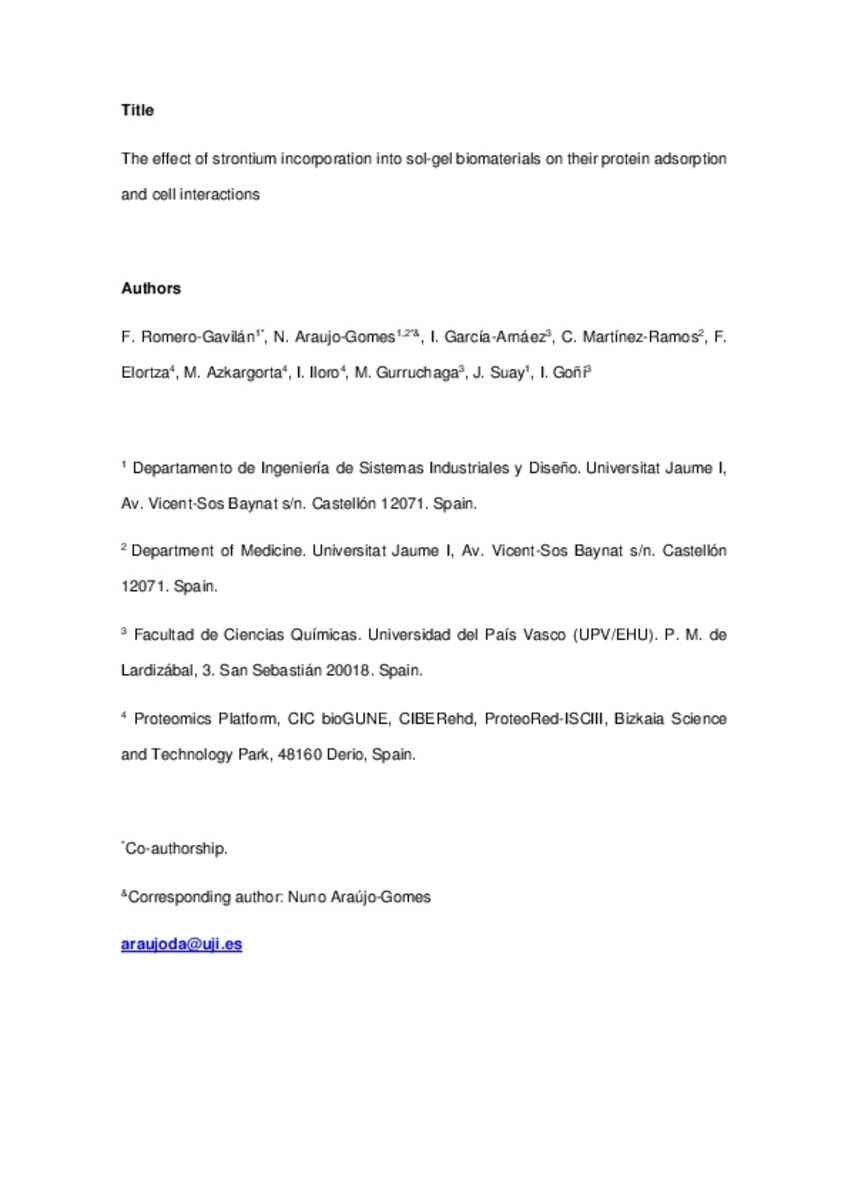| dc.contributor.author | Romero-Gavilán, Francisco J | |
| dc.contributor.author | Gomes, Nuno | |
| dc.contributor.author | García-Arnáez, Iñaki | |
| dc.contributor.author | Martinez Ramos, Cristina | |
| dc.contributor.author | Elortza, Felix | |
| dc.contributor.author | Azkargorta, Mikel | |
| dc.contributor.author | Iloro, Ibon | |
| dc.contributor.author | GURRUCHAGA, MARILO | |
| dc.contributor.author | Suay, Julio | |
| dc.contributor.author | Goñi, Isabel | |
| dc.date.accessioned | 2019-05-09T11:08:11Z | |
| dc.date.available | 2019-05-09T11:08:11Z | |
| dc.date.issued | 2019-02-01 | |
| dc.identifier.citation | ROMERO-GAVILÁN, F., et al. The effect of strontium incorporation into sol-gel biomaterials on their protein adsorption and cell interactions. Colloids and Surfaces B: Biointerfaces, 2019, vol. 174, p. 9-16 | ca_CA |
| dc.identifier.issn | 0927-7765 | |
| dc.identifier.issn | 1873-4367 | |
| dc.identifier.uri | http://hdl.handle.net/10234/182450 | |
| dc.description.abstract | It is known strontium can both inhibit the osteoclast formation and stimulate the osteoblast maturation, so biomaterials containing this element can favour bone structure stabilisation. The addition of Sr to biomaterials could affect their interactions with proteins and cells. Here, a silica-hybrid sol-gel network doped with different amounts of SrCl2 and applied as coatings on titanium discs was examined. in vitro analysis was performed to determine the potential effect of Sr in the coatings, showing enhanced gene expression of osteogenic markers (alkaline phosphatase and transforming growth factor-β) in MC3T3-E1 incubated with Sr-doped biomaterials. The examination of inflammatory markers (tumour necrosis factor-α and interleukin 10) in RAW 264.7 macrophages revealed an anti-inflammatory potential of these materials. Proteins adsorbed onto the coatings incubated with human serum (3 h at 37 °C) were also analysed; mass spectrometry was used to characterise the proteins adhering to materials with different Sr content. Adding Sr to the coatings increased their affinity to APOE and VTNC proteins (associated with anti-inflammatory and osteogenic functions). Moreover, the proteins involved in coagulation processes, such as prothrombin, were more abundant on the coatings containing Sr than on the base sol-gel surfaces. Correlations between gene expression and proteomic results were also examined. | ca_CA |
| dc.format.extent | 8 p. | ca_CA |
| dc.format.mimetype | application/pdf | ca_CA |
| dc.language.iso | eng | ca_CA |
| dc.publisher | Elsevier | ca_CA |
| dc.relation.isPartOf | Colloids and Surfaces B: Biointerfaces, 2019, vol. 174 | ca_CA |
| dc.rights | Copyright © Elsevier | ca_CA |
| dc.rights.uri | http://rightsstatements.org/vocab/InC/1.0/ | * |
| dc.subject | dental implants | ca_CA |
| dc.subject | apolipoprotein E | ca_CA |
| dc.subject | vitronectin | ca_CA |
| dc.subject | osteogenesis | ca_CA |
| dc.subject | bone regeneration | ca_CA |
| dc.subject | proteomics | ca_CA |
| dc.title | The effect of strontium incorporation into sol-gel biomaterials on their protein adsorption and cell interactions | ca_CA |
| dc.type | info:eu-repo/semantics/article | ca_CA |
| dc.identifier.doi | https://doi.org/10.1016/j.colsurfb.2018.10.075 | |
| dc.relation.projectID | MINECO: MAT2017-86043-R); Universitat Jaume I: Predoc/2014/25, UJI-B2017-37); Basque Government: IT611-13, Predoc/2016/1/0141; University of the Basque Country: UFI11/56 | ca_CA |
| dc.rights.accessRights | info:eu-repo/semantics/openAccess | ca_CA |
| dc.relation.publisherVersion | https://www.sciencedirect.com/science/article/pii/S0927776518307707 | ca_CA |
| dc.type.version | info:eu-repo/semantics/submittedVersion | ca_CA |







